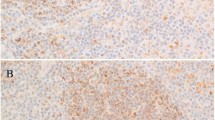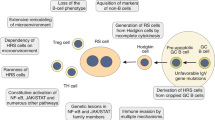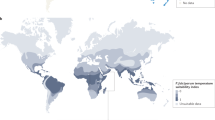Abstract
Retinoblastoma (Rb) tumour-suppressor protein plays a critical role in cell cycle control. Rb inactivation is a frequent phenomenon in tumours of different cell lineages, in which the absence of Rb protein has been considered to be a marker of Rb disregulation. We used modern immunohistochemical techniques to study the expression of Rb protein in a large series of 130 patients with Hodgkin's disease. Simultaneously, Western blot was used to analyse a more restricted group (12 patients) to confirm the immunohistochemical results and to clarify the phosphorylation status of Rb protein. As the level of Rb expression varied according to cell cycle stage, we also performed immunostaining for Ki67, a protein present in proliferating cells. To make comparison possible, we first characterised the amount and phosphorylation status of Rb protein in reactive lymphoid tissue and phytohaemagglutinin (PHA)-stimulated lymphocytes. The presence of p53 in Sternberg-Reed cells was also included in the study, as both proteins (p53 and Rb) have been found to be closely associated in cell cycle control. PHA-stimulated peripheral blood lymphocytes showed a parallel increase in Rb and cell cycle progression, together with progressive Rb phosphorylation. In reactive lymphoid tissue there was also a clear correlation between Rb expression and the Ki67 proliferation index (R = 0.96, P = 0.038). When analysing Hodgkin's disease samples, a clear difference emerges between cases of nodular lymphocyte predominance, which preserve the relationship between Rb and Ki67 expression (r = 0.8727, P = 0.000), and classical forms of Hodgkin's disease (nodular sclerosis and mixed cellularity), which display a strong deviation from this pattern. Two main anomalies were found: (1) One group of 21/130 cases with partial or total loss of Rb protein expression, which could reflect the existence of genetic alterations, or an altered transcriptional or translational regulation of Rb gene. (2) Another group with an abnormally high Rb/Ki67 ratio, which could support conflicting interpretations: (i) excess Rb protein for controlling cell cycle progression; or (ii) adhesion of Rb protein to other cellular or viral proteins, such as p53 and MDM2. The results of this study indicate an anomalous pattern of expression of Rb in classical forms of Hodgkin's disease, and suggest the possibility of undertaking functional studies (E1A adhesion, p16 expression) with the aim of better characterising the status of Rb protein, and correlating these findings with clinical course in Hodgkin's disease patients.
This is a preview of subscription content, access via your institution
Access options
Subscribe to this journal
Receive 24 print issues and online access
$259.00 per year
only $10.79 per issue
Buy this article
- Purchase on Springer Link
- Instant access to full article PDF
Prices may be subject to local taxes which are calculated during checkout
Similar content being viewed by others
Author information
Authors and Affiliations
Rights and permissions
About this article
Cite this article
Sánchez-Beato, M., Martínez-Montero, J., Doussis-Anagnostopoulou, T. et al. Anomalous retinoblastoma protein expression in Sternberg-Reed cells in Hodgkin's disease: a comparative study with p53 and Ki67 expression. Br J Cancer 74, 1056–1062 (1996). https://doi.org/10.1038/bjc.1996.489
Issue Date:
DOI: https://doi.org/10.1038/bjc.1996.489
This article is cited by
-
Retinoblastoma gene family expression in lymphoid tissues
Oncogene (2006)
-
Tumor suppressor genes in normal and malignant hematopoiesis
Oncogene (2002)



